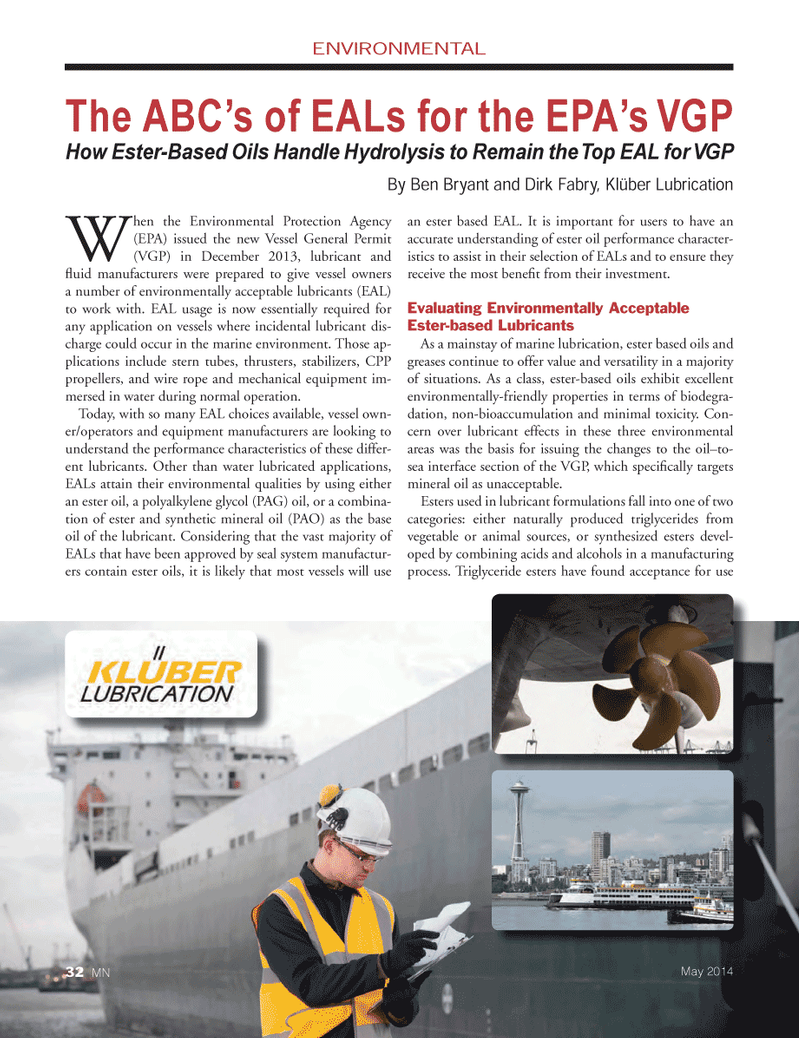
Page 32: of Marine News Magazine (May 2014)
Offshore Annual
Read this page in Pdf, Flash or Html5 edition of May 2014 Marine News Magazine
ENVIRONMENTAL
W hen the Environmental Protection Agency (EPA) issued the new Vessel General Permit (VGP) in December 2013, lubricant and fl uid manufacturers were prepared to give vessel owners a number of environmentally acceptable lubricants (EAL) to work with. EAL usage is now essentially required for any application on vessels where incidental lubricant dis- charge could occur in the marine environment. Those ap- plications include stern tubes, thrusters, stabilizers, CPP propellers, and wire rope and mechanical equipment im- mersed in water during normal operation.
Today, with so many EAL choices available, vessel own- er/operators and equipment manufacturers are looking to understand the performance characteristics of these differ- ent lubricants. Other than water lubricated applications,
EALs attain their environmental qualities by using either an ester oil, a polyalkylene glycol (PAG) oil, or a combina- tion of ester and synthetic mineral oil (PAO) as the base oil of the lubricant. Considering that the vast majority of
EALs that have been approved by seal system manufactur- ers contain ester oils, it is likely that most vessels will use an ester based EAL. It is important for users to have an accurate understanding of ester oil performance character- istics to assist in their selection of EALs and to ensure they receive the most benefi t from their investment.
Evaluating Environmentally Acceptable
Ester-based Lubricants
As a mainstay of marine lubrication, ester based oils and greases continue to offer value and versatility in a majority of situations. As a class, ester-based oils exhibit excellent environmentally-friendly properties in terms of biodegra- dation, non-bioaccumulation and minimal toxicity. Con- cern over lubricant effects in these three environmental areas was the basis for issuing the changes to the oil–to- sea interface section of the VGP, which specifi cally targets mineral oil as unacceptable.
Esters used in lubricant formulations fall into one of two categories: either naturally produced triglycerides from vegetable or animal sources, or synthesized esters devel- oped by combining acids and alcohols in a manufacturing process. Triglyceride esters have found acceptance for use
The ABC’s of EALs for the EPA’s VGP
How Ester-Based Oils Handle Hydrolysis to Remain the Top EAL for VGP
By Ben Bryant and Dirk Fabry, Klüber Lubrication
May 2014 32 MN
MN May14 Layout 32-49.indd 32 4/21/2014 10:29:33 AM

 31
31

 33
33
